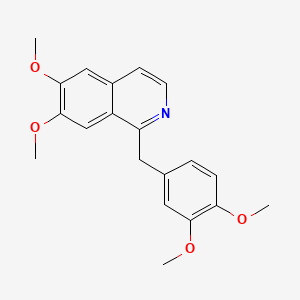D0293 | Papaverine
G
A
G04BE52 Papaverine, combinations
[G04BE] Drugs used in erectile dysfunction
[G04B] UROLOGICALS
[G04] UROLOGICALS
[G] Genitourinary system and reproductive hormones
G04BE02 Papaverine
[G04BE] Drugs used in erectile dysfunction
[G04B] UROLOGICALS
[G04] UROLOGICALS
[G] Genitourinary system and reproductive hormones
A03AD01 Papaverine
[A03AD] Papaverine and derivatives
[A03A] DRUGS FOR FUNCTIONAL GASTROINTESTINAL DISORDERS
[A03] DRUGS FOR FUNCTIONAL GASTROINTESTINAL DISORDERS
[A] Alimentary tract and metabolism
| Toxicity | Dose | Time | Species | Model | Method | Action | Positive criterion | Reference |
|---|---|---|---|---|---|---|---|---|
| UNCOUPLING | increase | 35 | ||||||
| ELECTRON TRANSPORT CHAIN | decrease | 30 | ||||||
| ELECTRON TRANSPORT CHAIN | 5 μM | bovine | mitochondria | NADH–Q-1 | decrease | IC50 | 30 | |
| Target | Dose | Time | Species | Model | Method | Action | Positive criterion | Reference |
|---|---|---|---|---|---|---|---|---|
| NADH:ubiquinone reductase | inhibitor | 30 | ||||||
| NADH:ubiquinone reductase | 5 μM | bovine | mitochondria | NADH–Q-1 | inhibitor | IC50 | 30 | |
| Pictogram | Signal | Statements | Precautionary Statement Codes |
|---|---|---|---|
 |
Warning |
H302: Harmful if swallowed [Warning Acute toxicity, oral] |
P264, P270, P301+P312, P330, and P501; (The corresponding statement to each P-code can be found at the GHS Classification page.) |
 |
Warning |
Aggregated GHS information provided by 6 companies from 1 notifications to the ECHA C&L Inventory. H302 (100%): Harmful if swallowed [Warning Acute toxicity, oral] Information may vary between notifications depending on impurities, additives, and other factors. The percentage value in parenthesis indicates the notified classification ratio from companies that provide hazard codes. Only hazard codes with percentage values above 10% are shown. |
P264, P270, P301+P312, P330, and P501; (The corresponding statement to each P-code can be found at the GHS Classification page.) |
 |
Warning |
H302: Harmful if swallowed [Warning Acute toxicity, oral] |
P264, P270, P301+P312, P330, and P501; (The corresponding statement to each P-code can be found at the GHS Classification page.) |
| 1-((3,4-Dimethoxyphenyl)methyl)-6,7-dimethoxyisoquinoline | 1-(3,4-Dimethoxy-benzyl)-6,7-dimethoxy-isoquinoline | 1-(3,4-Dimethoxybenzyl)-6,7-dimethoxyisoquinoline |
| 1-(3,4-Dimethoxybenzyl)-6,7-dimethoxyisoquinoline # | 1-[(3,4-Dimethoxyphenyl)methyl]6,7-dimethoxyisoquinoline | 1-[(3,4-dimethoxyphenyl)methyl]-6,7-dimethoxy-isoquinoline |
| 1-[(3,4-dimethoxyphenyl)methyl]-6,7-dimethoxyisoquinoline | 1-{[3,4-bis(methyloxy)phenyl]methyl}-6,7-bis(methyloxy)isoquinoline | 2wey |
| 4-[(6,7-Dimethoxyisoquinolyl)methyl]-1,2-dimethoxybenzene | 5-21-06-00182 (Beilstein Handbook Reference) | 58-74-2 |
| 6,7-DI-METHOXY-1-VERATRYLISOQUINOLINE | 6,7-DIMETHOXY-1-(3.4-DIMETHOXYBENZYL)-ISOQUINOLINE | 6,7-Dimethoxy-1-(3,4-dimethoxybenzyl)isoquinoline |
| 6,7-Dimethoxy-1-veratrylisoquinoline | 6,7-dimethoxy-1-veratryl-isoquinoline;hydrochloride | AB00053515 |
| AB00053515_14 | ACon1_000238 | ACon1_002094 |
| AKOS000277460 | ALBB-010475 | API0003747 |
| BBL012345 | BDBM14754 | BPBio1_000470 |
| BRD-K15567136-001-01-1 | BRD-K15567136-003-06-6 | BRD-K15567136-003-18-1 |
| BRN 0312930 | BSPBio_000426 | BSPBio_002153 |
| C06533 | CAS-61-25-6 | CCG-202821 |
| CHEBI:28241 | CHEMBL19224 | CS-7800 |
| CTK7A7298 | Ceraspan | D07425 |
| DAA13NKG2Q | DB-053252 | DB01113 |
| DTXSID4023418 | DivK1c_000321 | EINECS 200-397-2 |
| EV1 | FT-0631261 | HMS3561N11 |
| HMS3746M21 | HSDB 3147 | HY-18077 |
| IDI1_000321 | InChI=1/C20H21NO4/c1-22-17-6-5-13(10-18(17)23-2)9-16-15-12-20(25-4)19(24-3)11-14(15)7-8-21-16/h5-8,10-12H,9H2,1-4H | Isoquinoline, 1-((3,4-dimethoxyphenyl)methyl)-6,7-dimethoxy- |
| Isoquinoline, 1-[(3,4-dimethoxyphenyl)methyl]-6,7-dimethoxy- | Isoquinoline, 6,7-dimethoxy-1-veratryl- | Isoquinoline, 6,7-dimethoxy-1-veratryl- (8CI) |
| Isoquinoline, 6,7-dimethoxy-1-veratryl-(8Cl) | Isoquinoline,4-dimethoxyphenyl)methyl]-6,7-dimethoxy- | Isoquinoline,7-dimethoxy-1-veratryl- |
| KBio1_000321 | KBio2_000471 | KBio2_003039 |
| KBio2_005607 | KBio3_001653 | KBioGR_000914 |
| KBioSS_000471 | KS-00002WWI | KS-5336 |
| LS-85584 | Lopac-P-3510 | Lopac0_000957 |
| MCULE-9598291893 | MEGxp0_001880 | Mesotina (TN) |
| NCGC00015810-01 | NCGC00015810-02 | NCGC00015810-03 |
| NCGC00015810-04 | NCGC00015810-05 | NCGC00015810-06 |
| NCGC00015810-07 | NCGC00015810-08 | NCGC00015810-09 |
| NCGC00015810-13 | NCGC00024428-03 | NCGC00024428-04 |
| NCI60_003183 | NINDS_000321 | NSC 136630 |
| NSC-136630 | NSC136630 | NSC35443 |
| Oprea1_387689 | Oprea1_810508 | Papanerin |
| Papanerine | Papaverin | Papaverina |
| Papaverina [Italian] | Papaverine (BAN) | Papaverine [BAN] |
| Pavabid | Pavacot | Pavatym |
| Prestwick0_000583 | Prestwick1_000583 | Prestwick2_000583 |
| Prestwick3_000583 | Q410374 | R1247 |
| RS 47 | Robaxapap | S-M-R |
| SBI-0050931.P004 | SCHEMBL34702 | SDCCGMLS-0003037.P003 |
| SPBio_001015 | SPBio_002645 | SR-01000003098-10 |
| ST023301 | STK039035 | Spectrum2_000978 |
| Spectrum3_000537 | Spectrum4_000467 | Spectrum5_001188 |
| Spectrum_000071 | TNP00305 | UNII-DAA13NKG2Q |
| WLN: T66 CNJ B1R CO1 DO1& HO1 IO1 | XQYZDYMELSJDRZ-UHFFFAOYSA-N | Y1354 |
| ZINC56555 | papaverine |
| DrugBank Name | Papaverine |
| DrugBank | DB01113 |
| CAS Number | 127060-78-0, 132-40-1, 58-74-2, 61-25-6 |
| PubChem Compound | 4680 |
| KEGG Compound ID | C06533 |
| KEGG Drug | D07425 |
| PubChem.Substance | 46508003 |
| ChEBI | 28241 |
| PharmGKB | PA164745550 |
| ChemSpider | 4518 |
| BindingDB | 14754.0 |
| TTD | DAP000959 |
| Wikipedia | Papaverine |
| HET | EV1 |
| DPD | 6941|2957 |

